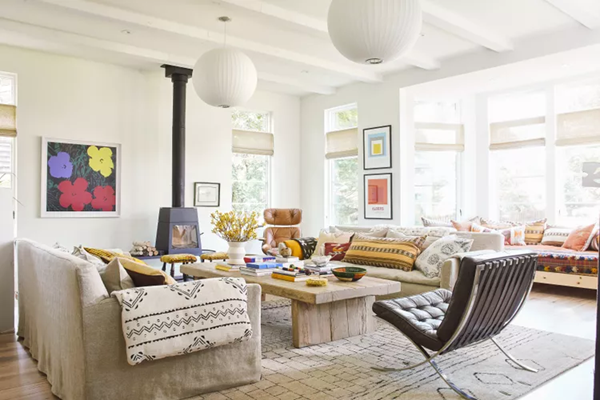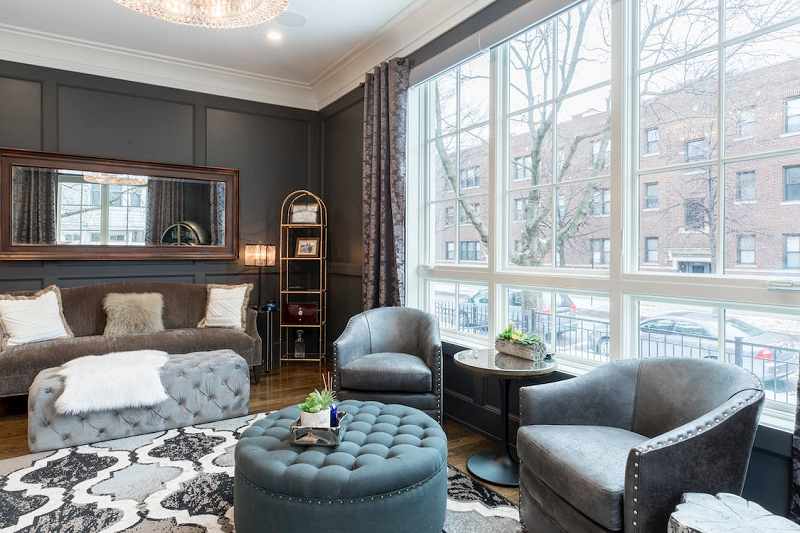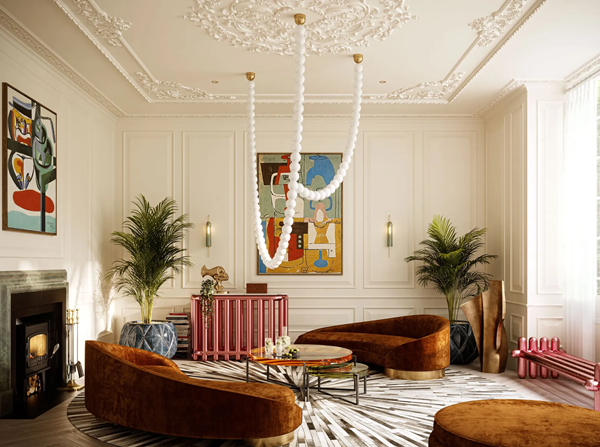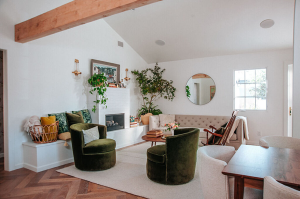How to arrange a small living room is not an easy thing to do. Maximizing space and creating a stylish living room is a universal desire, but it can be especially challenging when dealing with a limited footprint. Transforming a cozy living room into a functional and inviting haven is no small feat, but with the right approach, you can turn your small living room into a space that feels both expansive and intimate.
By embracing the principles of space optimization, furniture selection, strategic placement, and purposeful décor, you can transform your small living room into a haven of comfort, style, and visual delight.
How to Arrange a Small Living Room: Maximizing Space and Creating a Stylish Haven
Overcoming the Challenges of Small Living Spaces
Small living rooms often present unique challenges, such as limited floor space, awkward layouts, and a lack of natural light. These limitations can make it difficult to arrange furniture, incorporate décor, and create a sense of flow and functionality. However, by understanding the principles of space optimization and embracing smart design strategies, you can transform your small living room into a space that is both stylish and practical.
“Less furniture, more flow.”
Marie Kondo, organizing consultant and author
The Benefits of a Well-Arranged Small Living Room
How to arrange a small living room, arrangement is key. A well-arranged small living room can:
- Maximize floor space and create a sense of openness
- Enhance functionality and make the most of every square foot
- Improve traffic flow and ensure comfortable movement
- Create a visually appealing and inviting space
- Reflect your personal style and taste
Embark on Your Small Living Room Transformation
Whether you’re starting from scratch or looking to revamp your existing small living room, this comprehensive guide on how to arrange a small living room, will equip you with the knowledge and inspiration to create a space that is both stylish and functional. We’ll delve into the key principles of space optimization, furniture selection, strategic placement, and purposeful décor, providing you with practical tips and actionable strategies to transform your small living room into a haven you’ll love.

Throughout this guide, you’ll discover how to:
- Assess the layout and limitations of your small living room
- Choose furniture that is proportionally sized and serves multiple purposes
- Arrange furniture to maximize space and create a cohesive layout
- Utilize lighting, mirrors, and décor to enhance the sense of spaciousness
- Incorporate personal touches to reflect your unique style
So, get ready to learn the skill on how to transform your small living room into a space that is both functional and stylish. With careful planning, thoughtful design choices, and a touch of creativity, you can create a living room that is as comfortable and inviting as it is visually appealing.
“If you are looking for a way to style your space with wall art without breaking your piggy bank, then I recommend reading “10 Surprising Benefits of Printable Wall Art”
1. Understanding Your Small Living Room

Before you decide to start arranging your small living room, it’s crucial to understand its unique layout, limitations, and potential challenges. A thorough assessment of your living space will provide the foundation for making informed design decisions that maximize space, enhance functionality, and create a visually appealing environment.
Assessing the Layout
- Dimensions and Shape: Begin by measuring the length, width, and height of your living room. Note any irregular shapes or architectural features that may impact furniture placement.
- Fixed Elements: Identify the placement of windows, doors, fireplaces, and other fixed elements that cannot be moved. Consider how these elements influence the natural flow of light and movement within the room.
Defining Your Focal Point
- Natural Focal Point: Determine the natural focal point of your living room, such as a fireplace, a large window, or a television. This focal point will serve as the anchor for your furniture arrangement.
- Purpose and Alignment: Consider the primary purpose of your living room, whether it’s for relaxation, entertaining, or a combination of both. Ensure the focal point aligns with the intended use of the space.
- Guiding Arrangement: Use the focal point as a guide to arrange furniture and décor. The focal point should draw the eye and create a sense of balance within the room.
Identifying Traffic Flow
- Natural Movement: Observe the natural flow of movement through the living room. Identify areas where people frequently walk or enter and exit.
- Unobstructed Flow: Ensure furniture placement doesn’t obstruct the natural flow of traffic or create congestion. Maintain comfortable clearance between furniture pieces and walkways.
- Smooth Transitions: Aim for a smooth transition between different areas of the living room, such as the conversation area, the entryway, and the dining area.
“Remember, less is more! Edit ruthlessly and prioritize pieces you truly love. A curated collection adds personality and avoids visual overwhelm.”
Kelly Wearstler, interior designer
2. How to Design a Long Living Room

Long living rooms present a unique challenge due to their elongated shape. To effectively arrange furniture and create a sense of balance, consider these tips:
- Define Zones: Divide the long room into distinct zones, such as a conversation area, a reading nook, or a workspace. Use furniture placement and area rugs to visually define these zones.
- Create Depth: Introduce visual depth by placing furniture across the width of the room rather than along the long walls. This creates a more balanced and inviting space.
- Balance Proportions: Choose furniture that is proportionally sized to the room’s width. Avoid pieces that are too large or too small, which can throw off the balance of the space.
- Emphasize Focal Points: Create multiple focal points along the length of the room to break up the monotony. Use a fireplace, a large window, or an accent wall to create visual interest.
- Embrace Negative Space: Don’t feel compelled to fill every corner of the room. Negative space can make the room feel more spacious and less cluttered.
By understanding these key principles of layout, focal points, and traffic flow, you’ll gain a deeper understanding of your small living room’s unique characteristics and lay the groundwork for a well-arranged and functional space.
3. Choosing the Right Furniture for Your Small Living Room

How to arrange a small living room design, furniture selection plays a pivotal role in maximizing space, enhancing functionality, and creating a visually appealing environment. By carefully considering the size, scale, and versatility of furniture pieces, you can transform your small living room into a haven of comfort, style, and practicality.
Scale Matters: A Symphony of Proportion
When selecting furniture for a small living room, scale is paramount. Oversized furniture can overpower the space, creating a cramped and cluttered feel. Conversely, undersized pieces can get lost in the room, making it feel disjointed and unbalanced.
- Proportional Harmony: Opt for furniture pieces that are proportionally sized to the dimensions of your living room. Avoid bulky or oversized sofas, armchairs, and tables that can overwhelm the space.
- Sleek and Streamlined: Embrace sleek, streamlined designs that create a sense of openness and visual lightness. Avoid furniture with bulky frames or excessive ornamentation that can make the room feel smaller.
- Mind the Gaps: Maintain a comfortable distance between furniture pieces to allow for easy movement and prevent congestion. Avoid pushing furniture directly against walls, which can create a crowded and claustrophobic feel.
Multifunctional Furniture: A Space-Saving Ally
In a small living room, every piece of furniture should serve multiple purposes, maximizing space and enhancing functionality. Multifunctional furniture pieces are your best allies in creating a versatile and practical living space.
“Multitasking furniture is your friend! Opt for pieces with dual purposes, like ottomans with storage or sofas with pull-out beds.”
Nate Berkus, decorator and television personality
- Ottomans with Storage: Ottomans with hidden storage compartments provide additional seating, footrests, and coffee tables while concealing clutter and maximizing space.


- Coffee Tables with Extendable Leaves: Coffee tables with extendable leaves seamlessly transition from everyday use to accommodating guests, offering flexibility and practicality.


- Sofas with Built-in Beds: Sofas with built-in beds provide dual functionality, serving as both a comfortable seating area and a convenient sleeping option for guests.


Low-Profile Furniture: Creating an Illusion of Height
In a small living room, low-profile furniture plays a crucial role in visually expanding the room’s height. By opting for furniture with lower profiles, you can create a sense of airiness and spaciousness.
- Low-Profile Sofas and Armchairs: Choose sofas and armchairs with lower seat heights and backrests to avoid making the room feel cramped and closed in.


- Low-Profile Coffee Tables: Opt for coffee tables with lower heights to prevent them from visually dominating the space.


- Space-Saving TV Stands: Mount your television on the wall or use a low-profile TV stand to conserve floor space and avoid blocking the natural flow of light.


By embracing these principles of scale, versatility, and low-profile design, you can select furniture pieces that not only enhance the style and comfort of your small living room but also maximize space and functionality.
4. Arranging Furniture for Optimal Space Utilization

Once you’ve carefully selected furniture that is proportionally sized, multifunctional, and low-profile, it’s time to master the art of furniture placement to optimize space utilization in your small living room. Strategic arrangement will ensure a comfortable, functional, and visually appealing layout.
The Conversation Area: A Hub for Connection
The conversation area is the heart of your small living room, a space for relaxation, socializing, and enjoying quality time. Arrange the main seating pieces, such as sofas and armchairs, to create a conversational circle that facilitates interaction and engagement.
- Focal Point Alignment: Position the focal point, whether it’s a fireplace, a TV, or a large window, within the conversation circle to serve as a natural gathering point.
- Ample Seating Space: Ensure comfortable spacing between seating pieces to allow for easy movement and conversation. Avoid overcrowding the area, which can make it feel cramped and uncomfortable.
- Varied Seating Options: Include a combination of sofas, armchairs, and ottomans to provide flexibility in seating arrangements and accommodate different group sizes.
- Consider Traffic Flow: Maintain clear pathways around the conversation area to avoid obstructing traffic flow or creating congestion. Allow ample space for movement between the seating area and other areas of the living room.
Furniture Placement: A Dance of Form and Function
Strategic furniture placement is key to how to arrange a small living room to maximizing your space, enhancing functionality, and creating a cohesive layout in your small living room. Follow these guidelines to optimize the arrangement of your furniture pieces.
- Wall-Hugging Strategy: Push furniture pieces against the walls whenever possible to create a sense of spaciousness and define distinct areas within the room.
- Visual Distance: Avoid placing furniture directly against the walls; maintain a comfortable visual distance to prevent a cluttered feel and allow for air circulation.
- Floating Furniture: Consider floating furniture pieces, such as sofas and armchairs, to define different areas within the living room and create a sense of openness.
- Purposeful Pathways: Ensure clear pathways between furniture pieces and walkways to maintain a comfortable flow of movement. Avoid blocking access to windows, doors, or other functional elements.
- Focal Point Harmony: Arrange furniture to complement the focal point, creating a balanced and visually appealing layout. Avoid obstructing the view of the focal point or drawing attention away from it.
Utilizing Negative Space: Embracing the Art of Emptiness
Negative space, the empty areas between furniture pieces, plays a crucial role in creating a sense of spaciousness and visual lightness in a small living room. Embrace negative space rather than filling every corner with furniture.
- Avoid Clutter: Resist the urge to fill every corner of the room. Negative space allows the eye to rest and makes the room feel less cluttered and more inviting.
- Highlight Focal Points: Utilize negative space to draw attention to specific furniture pieces or décor elements. Surround a statement piece with ample negative space to emphasize its presence.
- Balanced Layout: Create a balanced layout by incorporating negative space throughout the room. Avoid placing furniture in a single corner or creating an unbalanced distribution of objects.
By mastering the art of furniture arrangement, you can transform your small living room into a space that is both functional and visually appealing. Embrace strategic placement, consider traffic flow, and utilize negative space to create a layout that maximizes space, enhances comfort, and reflects your personal style.
5. Enhancing Your Small Living Room with Décor

How to arrange a small living room, décor plays a pivotal role in elevating the space’s style, enhancing its functionality, and creating a sense of ambiance. By carefully selecting and strategically incorporating décor elements, you can transform your small living room into a haven of comfort, style, and visual delight.
Strategic Lighting: Illuminating Your Small Living Room
Lighting is a transformative element in any interior space, and in a small living room, it plays a crucial role in creating a sense of spaciousness, warmth, and ambiance. Employ a combination of ambient, task, and accent lighting to illuminate your small living room effectively.
- Ambient Lighting: Establish a well-distributed base level of ambient lighting to ensure the entire room is bathed in a warm, inviting glow. Utilize ceiling lights, wall sconces, or floor lamps to provide general illumination


- Task Lighting: Incorporate task lighting to specific areas where focused illumination is needed, such as reading nooks, workspaces, or areas with limited natural light. Use desk lamps, table lamps, or pendant lights for task lighting.


- Accent Lighting: Add depth, dimension, and visual interest with accent lighting. Highlight architectural features, artwork, or statement furniture pieces with strategically placed accent lights, such as uplights, downlights, or track lighting.


Mirrors for Illusion: Reflecting a Sense of Spaciousness
Mirrors are a powerful tool in small living room design, as they can visually expand the space and create an illusion of spaciousness. Strategically placed mirrors can reflect natural light, enhance depth perception, and add a touch of elegance to the décor.
“Mirrors are your secret weapon! They visually expand the room and reflect light, making it feel brighter and airier.”
Joanna Gaines, designer and television personality
- Opposite Windows: Hang mirrors opposite windows to amplify natural light and bounce it around the room, making the space feel brighter and more open.


- Full-Length Mirrors: Utilize full-length mirrors to visually expand the room’s height, drawing the eye upwards and creating a taller-looking space.


- Strategic Placement: Place mirrors to reflect interesting architectural features, artwork, or focal points, adding visual interest and drawing attention to desired elements.


Décor with Purpose: A Symphony of Style and Functionality
Choose décor elements that complement the overall style of your small living room and serve a specific purpose. Avoid clutter and visual overload by carefully selecting and strategically placing décor pieces.
- Purposeful Accents: Incorporate décor that enhances the functionality of the space, such as ottomans with storage, decorative trays for organizing clutter, or baskets for storing blankets and throws.
- Color Harmony: Use color strategically to create a sense of balance and cohesiveness. A neutral color palette can make the room feel more spacious, while pops of color can add personality and visual interest.
- Personal Touches: Infuse your small living room with personal touches that reflect your unique style and interests. Display artwork, souvenirs, or cherished items that bring you joy and add a sense of character to the space.
By embracing strategic lighting, incorporating well-placed mirrors, and selecting décor with purpose, you can elevate the style, functionality, and ambiance of your small living room, transforming it into a space that is both visually appealing and inviting.
Most Popular Post:
10 Surprising Benefits of Printable Wall Art
15 Must-Have Accessories For Styling A Coffee Table
How to Choose the Perfect Interior Color Scheme for Your Home
Expert Guide On How To Buy A Rug For Each Room
Share Your Small Living Room Transformation Journey

We invite you to share your small living room transformation journey with me and the wider community of interior design enthusiasts. Share your before-and-after photos, your favorite design tips, and the challenges you overcame along the way. Inspire others to embrace the possibilities of small living spaces and create homes that are both functional and stylish.
Join the Conversation
Share your small living room design experiences, ask questions, and seek advice in our online community forums. Connect with fellow homeowners and renters who are passionate about creating beautiful and functional spaces, regardless of their size.
Subscribe for More Inspiration
Sign up for our newsletter to receive regular updates on the latest small living room design trends, tips, and inspiration. I’ll deliver fresh ideas and practical advice directly to your inbox, helping you keep your small living room looking and feeling its best.
Let Your Creativity Shine
Your small living room is a blank canvas waiting for your personal touch. Embrace your creativity, experiment with different styles, and let your unique personality shine through your décor choices. Create a space that reflects your taste, your lifestyle, and your love for home.
Together, let’s celebrate the transformative power of how to arrange a small living room small living room and inspire others to create spaces that are both stylish and functional, regardless of their size.
Conclusion: A Transformed Small Living Room
As you conclude your journey on how to arrange a small living room to help you transform your small living room, take a moment to appreciate the remarkable transformation you have achieved. By applying the principles of space optimization, furniture selection, strategic placement, and purposeful décor, you have created a space that is both functional and stylish, a reflection of your personal taste and a haven for relaxation, entertainment, and connection.
Embrace the Art of Small Living Room Design
Remember that small living room design is not about limitations; it’s about creativity, resourcefulness, and a passion for creating a space that truly feels like home. Embrace the unique challenges and opportunities that come with a small footprint, and let your imagination soar as you curate a space that is both practical and aesthetically pleasing.
Inspiring Others Through Your Transformation
Share your small living room transformation journey with others, inspiring fellow homeowners and renters to embrace the possibilities of small living spaces. Encourage them to experiment with different layouts, explore creative décor ideas, and discover the joys of creating a cozy and inviting space, regardless of its size.
Your Small Living Room Awaits
As you step back into your transformed small living room, let a sense of pride and accomplishment wash over you. You have mastered the art of small living room design, creating a space that is not only functional and stylish but also a testament to your creativity, resourcefulness, and passion for interior design. Embrace the warmth and inviting ambiance of your transformed living room, ready to welcome guests, unwind after a long day, and create cherished memories within its cozy confines.
FAQs
Q: How can I make my small living room feel more spacious?
A: There are a few things you can do to make your small living room feel more spacious:
- Choose light and airy furniture: Avoid bulky or oversized furniture that can make the room feel cramped. Opt for sleek, streamlined pieces that create a sense of openness.
- Use negative space: Don’t feel compelled to fill every corner of the room. Negative space can make the room feel more spacious and less cluttered.
- Incorporate mirrors: Mirrors can reflect light and make the room feel larger. Hang mirrors opposite windows to amplify natural light.
- Use light colors: Light colors can make the room feel more open and airy. Avoid using dark colors, which can make the room feel smaller.
Q: How can I arrange my furniture in my small living room?
A: There are a few things to consider when arranging your furniture in your small living room:
- The focal point: Determine the focal point of your living room, such as a fireplace, a window, or a TV. Arrange your furniture to create a conversational area around the focal point.
- Traffic flow: Ensure furniture placement doesn’t obstruct the natural flow of traffic through the living room. Maintain a comfortable distance between furniture pieces and walkways.
- Scale: Choose furniture pieces that are proportionally sized to the room. Avoid pieces that are too large or too small, which can throw off the balance of the space.
Q: What décor can I use in my small living room?
A: When choosing décor for your small living room, it’s important to select pieces that are both functional and stylish. Here are a few tips:
- Choose multifunctional pieces: Look for pieces that serve multiple purposes, such as ottomans with storage or coffee tables with extendable leaves.
- Use small-scale décor: Avoid large décor pieces that can overwhelm the space. Opt for smaller pieces, such as candles, throw pillows, and small artwork.
- Incorporate natural elements: Plants and flowers can add a touch of life and color to your small living room without taking up too much space.
Q: How can I make my small living room feel more cozy?
A: To make your small living room feel more cozy, try these tips:
- Use warm colors: Warm colors, such as reds, oranges, and yellows, can create a cozy and inviting atmosphere.
- Lay down rugs: Rugs can add a sense of warmth and texture to your living room. Choose a rug that is the right size for your space and complements your décor.
- Use soft lighting: Avoid harsh overhead lighting. Instead, use lamps and candles to create a soft and inviting glow.
- Add personal touches: Decorate your living room with personal touches, such as family photos, books, and souvenirs. These items will make your living room feel more like home.
CATCH THE LATEST IN HOME DECOR TRENDS:

Steal These 15 Expert-Approved Decorating Secrets

How To Accessories Your Living Room

Small Space? 10 Ways To Make A Room Appear Bigger

Make Your space Look Expensive
GET CAUGHT UP ON ALL THE INSPIRING DECOR TIPS:

18 Fresh Decorating Ideas To Update Your Fireplace

How To Create An Art Gallery Wall
